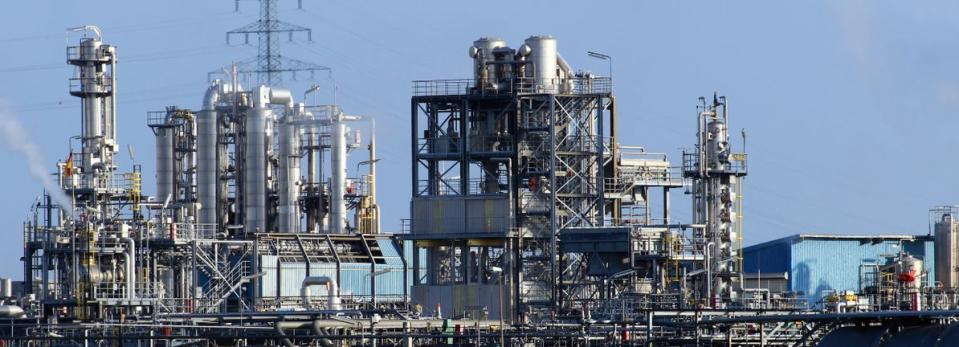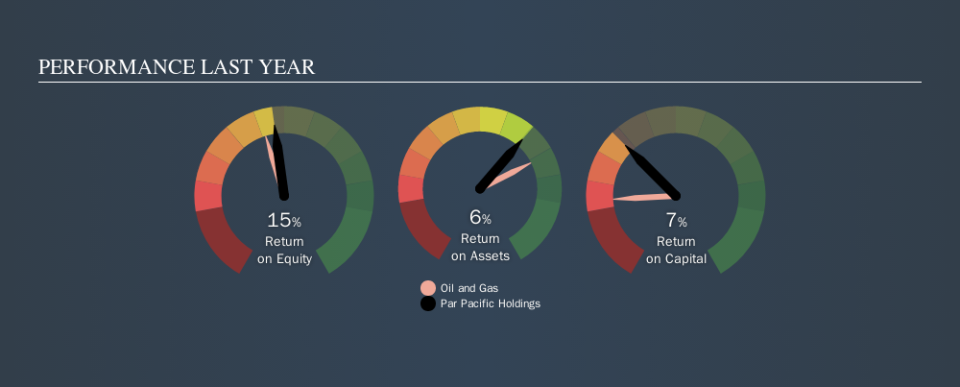Why Par Pacific Holdings, Inc.’s (NYSE:PARR) Return On Capital Employed Might Be A Concern

Today we'll look at Par Pacific Holdings, Inc. (NYSE:PARR) and reflect on its potential as an investment. In particular, we'll consider its Return On Capital Employed (ROCE), as that can give us insight into how profitably the company is able to employ capital in its business.
Firstly, we'll go over how we calculate ROCE. Next, we'll compare it to others in its industry. Then we'll determine how its current liabilities are affecting its ROCE.
What is Return On Capital Employed (ROCE)?
ROCE is a measure of a company's yearly pre-tax profit (its return), relative to the capital employed in the business. In general, businesses with a higher ROCE are usually better quality. Overall, it is a valuable metric that has its flaws. Renowned investment researcher Michael Mauboussin has suggested that a high ROCE can indicate that 'one dollar invested in the company generates value of more than one dollar'.
How Do You Calculate Return On Capital Employed?
The formula for calculating the return on capital employed is:
Return on Capital Employed = Earnings Before Interest and Tax (EBIT) ÷ (Total Assets - Current Liabilities)
Or for Par Pacific Holdings:
0.066 = US$112m ÷ (US$2.7b - US$974m) (Based on the trailing twelve months to June 2019.)
Therefore, Par Pacific Holdings has an ROCE of 6.6%.
View our latest analysis for Par Pacific Holdings
Does Par Pacific Holdings Have A Good ROCE?
When making comparisons between similar businesses, investors may find ROCE useful. We can see Par Pacific Holdings's ROCE is meaningfully below the Oil and Gas industry average of 8.3%. This performance could be negative if sustained, as it suggests the business may underperform its industry. Separate from how Par Pacific Holdings stacks up against its industry, its ROCE in absolute terms is mediocre; relative to the returns on government bonds. Investors may wish to consider higher-performing investments.
In our analysis, Par Pacific Holdings's ROCE appears to be 6.6%, compared to 3 years ago, when its ROCE was 0.8%. This makes us wonder if the company is improving. The image below shows how Par Pacific Holdings's ROCE compares to its industry, and you can click it to see more detail on its past growth.
Remember that this metric is backwards looking - it shows what has happened in the past, and does not accurately predict the future. ROCE can be misleading for companies in cyclical industries, with returns looking impressive during the boom times, but very weak during the busts. ROCE is, after all, simply a snap shot of a single year. Given the industry it operates in, Par Pacific Holdings could be considered cyclical. Future performance is what matters, and you can see analyst predictions in our free report on analyst forecasts for the company.
How Par Pacific Holdings's Current Liabilities Impact Its ROCE
Current liabilities are short term bills and invoices that need to be paid in 12 months or less. Due to the way the ROCE equation works, having large bills due in the near term can make it look as though a company has less capital employed, and thus a higher ROCE than usual. To check the impact of this, we calculate if a company has high current liabilities relative to its total assets.
Par Pacific Holdings has total assets of US$2.7b and current liabilities of US$974m. Therefore its current liabilities are equivalent to approximately 36% of its total assets. Par Pacific Holdings has a medium level of current liabilities, which would boost its ROCE somewhat.
Our Take On Par Pacific Holdings's ROCE
Unfortunately, its ROCE is still uninspiring, and there are potentially more attractive prospects out there. But note: make sure you look for a great company, not just the first idea you come across. So take a peek at this free list of interesting companies with strong recent earnings growth (and a P/E ratio below 20).
I will like Par Pacific Holdings better if I see some big insider buys. While we wait, check out this free list of growing companies with considerable, recent, insider buying.
We aim to bring you long-term focused research analysis driven by fundamental data. Note that our analysis may not factor in the latest price-sensitive company announcements or qualitative material.
If you spot an error that warrants correction, please contact the editor at editorial-team@simplywallst.com. This article by Simply Wall St is general in nature. It does not constitute a recommendation to buy or sell any stock, and does not take account of your objectives, or your financial situation. Simply Wall St has no position in the stocks mentioned. Thank you for reading.

